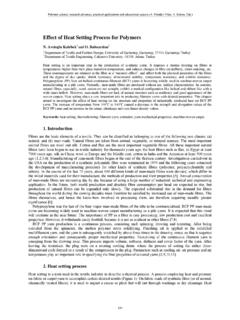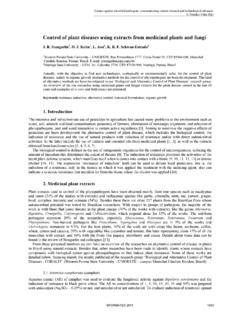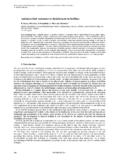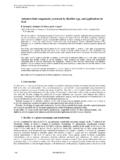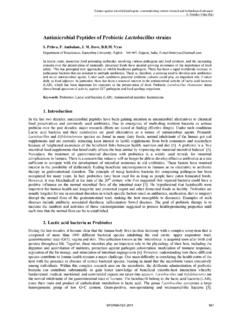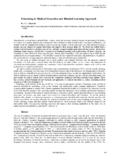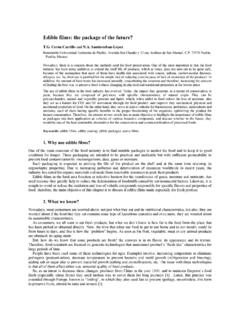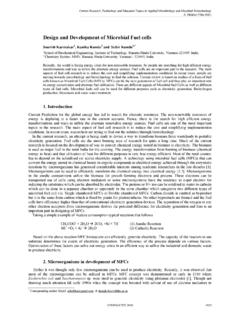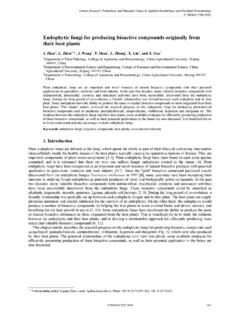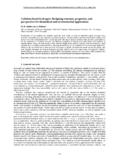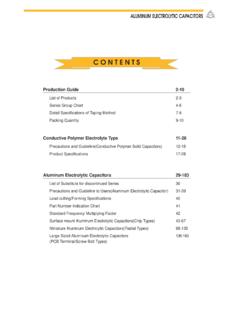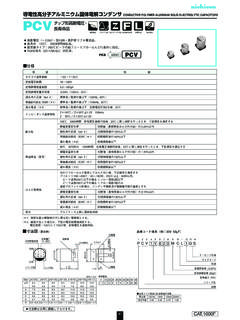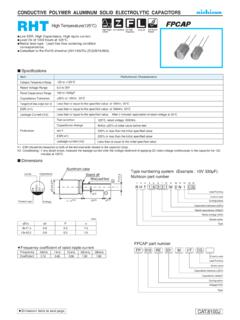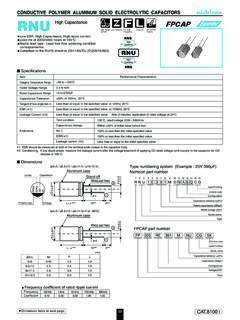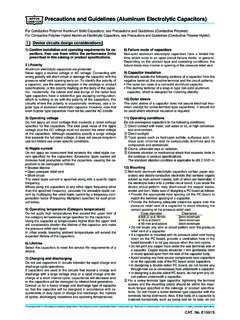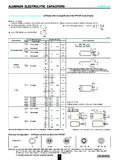Transcription of Thermal conductivity of particle-filled polymers
1 polymer science: research advances, practical applications and educational aspects (A. M ndez-Vilas; A. Solano, Eds.). _____. Thermal conductivity of particle- filled polymers Ngo1,2 and C. Byon1,*. 1. School of Mechanical Engineering, Yeungnam University, Gyeongsan, 712-749, South Korea 2. School of Transportation engineering, Hanoi University of Science & Technology, Hanoi, 112-452, Vietnam * Corresponding Author: Telephone: +82-53-810-2452, Fax: +82-53-810-4627, E-mail: This study reviews the considerations on Thermal conductivity (TC) of particle- filled polymers and develops a numerical approach.
2 A comprehensive and extensive review on the TC of transparent and flexible polymer (TFP) composites is first presented. The discussion covers TFPs filled with many highly conductive materials using various experimental methods and measurement techniques. A variety of theoretical, empirical, and models based on numerical methods are discussed. Since each model is suitable for only specific composites, analytical models should be considered more extensively for general problems. Using a numerical approach, the TC can be improved effectively under appropriate conditions for polymers filled with single and hybrid micro-/nanoparticles.
3 Various guidelines for achieving the maximum TC and enhancing it are provided. Particularly, novel correlations are proposed that can be widely used for accurately and effectively predicting the TC of such polymer composites. This study provides better understanding of research trends of polymer science, particularly the TFPs. Keywords: Analytical model; Particle filler; Thermal conductivity ; Transparent and flexible polymer 1. Background Thermal conductivity of pure polymers Thermal conductivity (TC or k hereafter) is an important property in material science and technology, electronics, building insulation, and related fields, particularly when high operating temperature is required.
4 It characterizes the ability of a material to conduct heat flow. The TC has been studied extensively for both polymers and processing for potential applications. However, polymers typically have much lower intrinsic TC than metals or ceramic materials, making them good Thermal insulators. As shown in Table 1, the TC of pure polymers is commonly very low (less than W/(m K)). In general, the TC of a material is primarily evaluated using Fourier's law in steady-state Thermal conduction. For polymers , however, the Debye kinetic equation, k = Cpv /3, is usually used for theoretical prediction.
5 In this equation, Cp is the specific heat capacity per unit volume, v is the average velocity of a phonon. is the phonon mean free path which is the average distance that a phonon travels between two collisions. Lopes and Felisberti [3] indicated that a phonons' average free path is the main parameter a ecting the TC of composites. For amorphous polymers , is an extremely small constant (a few angstroms) due to phonon scattering from numerous defects, which is why the TC of pure polymers is so low. Table 1 TCs of well-known polymers at room temperature [1, 2].
6 Name k [W/(m K)] Name k [W/(m K)]. High density polyethylene (HDPE) Poly(dimethylsiloxane) (PDMS) Polyphenylsulfone (PPSU) Polysulfone (PSU) Poly(ethylene vinyl acetate) (EVA) Polymethylmethacrylate (PMMA) Poly(acrylonitrile-butadiene-styrene) (ABS) Polycarbonate (PC) Low density polyethylene (LDPE) Polyvinyl chloride (PVC) Polyphenylene sulfide (PPS) Polyvinylidene difluoride (PVDF) Poly(butylene terephthalate) (PBT) Epoxy resin (ER) Polytetrafluoroethylene (PTFE) Poly(ethylene terephthalate) (PET) (PA66) Polystyrene (PS) Nylon-6 (PA6) Polypropylene (PP)
7 Polyetheretherketone (PEEK) Polyethylene (PE) Polytetrafluoroethylene (PTFE) Polyimide, Thermoplastic (PI) According to quantum mechanics, the elastic waves (or sound waves) from lattice vibration of immobile positive ions and free electrons (electron gas) in a solid also behave as particles , which are called phonons . We can thus consider a solid as a dilute gas of phonons. For an isotropic solid polymer structure, the phonon mean free path is equivalent to that of a gas. Yang provides the TC of various polymers in a polymer handbook [4]. Tritt provides measurement techniques for determining the TC of a bulk material, such as the radial flow method, laser-flash diffusivity, and pulse-power method 554.
8 polymer science: research advances, practical applications and educational aspects (A. M ndez-Vilas; A. Solano, Eds.). _____. [5]. The membrane method, bridge method, and photothermal emission method for thin-film materials have also been considered. These approaches are very useful for understanding the physical properties and mechanical behaviors of polymers , particularly the TC. To enhance the TC of a material in applications requiring thermally conductive polymer , a common method is to add a filler with higher TC to the pure polymers while maintaining the other properties as much as possible.
9 Thermal conductivity of particle- filled polymers polymers reinforced with organic or inorganic micro-/nanoparticle fillers are becoming more and more common in applications that require highly conductive polymer . Examples include electronic packaging for flexible- polymer electronics, encapsulations, satellite devices, and areas where good heat dissipation, low Thermal expansion, and light weight are needed [6]. The TC of polymers has traditionally been enhanced by the addition of thermally conductive fillers, including graphite, carbon black (CB), carbon fibers, and ceramic or metal particles .
10 The fillers have much higher TC than that of pure polymers (Table 2). For example, the TC of planar graphite is as high as 3000 W/(m K). [10]. It is evident that particle- filled polymers have many advantages due to their easy processability, low cost, and durability against corrosion. Tavman [11] provided the following reasons for using fillers: improving TC and diffusivity, electrical conductivity or magnetic permeability, stiffening the matrix material, reducing internal stresses in injection molded parts, reducing creep, reducing cost, and improving the appearance of the final product.
